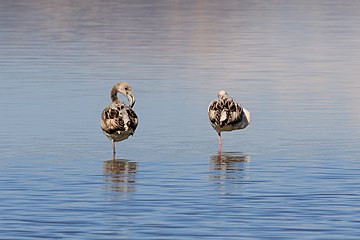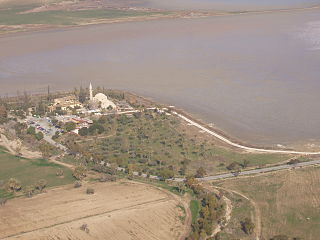Larnaca Salt Lake
| Larnaca Salt Lake | |
|---|---|
 in winter with part of Larnaca city in the background. | |
| Coordinates | 34°54′N33°37′E/ 34.900°N 33.617°E |
| Basincountries | Cyprus |
| Surface area | 1,585 ha (3,920 acres)[1] |
| Average depth | 1 m (3 ft 3 in) |
| Surface elevation | 0 m (0 ft) |
| Settlements | Larnaca |
| References | [1] |
| Designated | 11 July 2001 |
| Reference no. | 1081[2] |
Larnaca Salt Lake(Greek:Αλυκή Λάρνακας,romanized:Alykí Lárnakas,Turkish:Larnaka Tuz Gölü) is a complex network of foursalt lakes(3 of them interconnected) of different sizes to the west of the city ofLarnaca.The largest is lakeAliki,followed by lakeOrphani,lakeSorosand lakeSpiro.[3]They form the second largestsalt lakeinCyprusafter theLimassol Salt Lake.The total surface area of the lakes adds up to 2.2 km2and being just off the road leading toLarnaca International Airport,the lake is one of the most distinctive landmarks of the area. It is considered one of the most important wetlands of Cyprus and it has been declared aRamsarsite,Natura 2000site, Special Protected Area under theBarcelona Convention[4]and an Important Bird Area (IBA).[5]It is surrounded byhalophyticscrubland and on its bank lies theHala Sultan Tekke,one of the holiest of shrines within OttomanIslam.It houses the tomb ofUmm Haram,Muhammad's 'wet-nurse'.
Besides its picturesque beauty, the lake is the haunt of 85 species of water-birds with estimated populations between 20,000 and 38,000.[citation needed]It is one of the important migratory passages through Cyprus. Among the species are 2,000–12,000 flamingoes (Phoenicopterus roseus)[6]which spend the winter months there feeding off populations of thebrine shrimpArtemia salina.[3]Other important bird species areGrus grus,Charadrius alexandrinus,Larus ridibundus,Himantopus himantopus,Burhinus oedicnemus,Hoplopterus spinosus,Oenanthe cypriacaandSylvia melanothorax.[citation needed]Flocks of birdwatchers gather to observe the blaze of pink from flamingoes as they gather in the centre of the lake but also the other important migrants. The Larnaca Salt Lake complex was declared as a protected area by a decision of the Council of Ministers in 1997.[7] Recent evidence suggests that contrary to previous belief thegreater flamingo(Phoenicopterus roseus) not only stops over but also breeds on this wetland.[8]
During the winter months the lake fills with water while in the summer the water evaporates, leaving a crust of salt and a haze of grey dust. According to legend, the lake's saltiness stems from St Lazarus' request to an old woman for food and drink. She refused, claiming her vines had dried up, to whichLazarusreplied: "may your vines be dry and be a salt lake forever more."[9]A more scientific explanation is that the salt water penetrates the porous rock between the lake and the sea, making the water very salty.[citation needed]
Salt harvested from this lake used to be one of the island's major exports, being collected with donkeys, carried to the edge of the lake, and piled up into huge pyramidal heaps. With rising labour costs harvesting dwindled to a negligible amount and stopped altogether in 1986[3]as the island now imports most of this commodity.[citation needed]
Gallery[edit]
-
Flamingos on the lake
-
Aerial photo of the Larnaca Salt Lake (in winter) withHala Sultan Tekke
References[edit]
- ^ab"The Annotated Ramsar List: Cyprus".Ramsar Convention Secretariat. 24 August 2001. Archived fromthe originalon 29 June 2008.Retrieved6 June2016.
- ^"Larnaca Salt Lake".RamsarSites Information Service.Retrieved25 April2018.
- ^abc"Report of the environmental audit of the city of Larnaca"(PDF).Medcities. May 1999.Retrieved2007-03-29.
- ^Kassinis, Nicolaos; Michalis Antoniou (October 2006)."Proceedings of the first symposium on the Mediterranean action plan for the conservation of marine and coastal birds (p94)"(PDF).Archived fromthe original(PDF)on September 29, 2007.Retrieved2007-03-29.
- ^Iezekiel S., Makris C., Antoniou A. (2004)Important Bird Areas of European Union Importance in Cyprus.Birdlife Cyprus, Lefkosia 2004.
- ^"BirdLife IBA Factsheet - Larnaca salt-lake".BirdLife International. 2006.Retrieved2007-03-25.
- ^Hadjichristoforou, Myroula (8 December 2004)."5th European Regional Meeting on the implementation and effectiveness of the Ramsar Convention"(PDF).Ramsar.Archived fromthe original(PDF)on January 6, 2006.Retrieved2007-03-25.
- ^Hadjisterkotis, E.; M. Charalambides (September 30, 2005). "The first evidence for the breeding of the Greater FlamingoPhoenicopterus ruberon Cyprus (Erster Brutnachweis des Flamingos Phoenicopterus ruberauf Zypern) ".Zeitschrift für Jagdwissenschaft.48(Supplement 1): 72–76.doi:10.1007/BF02192394.S2CID21090604.
- ^"Saint Lazare in Larnaca".Damianos Foundation. Archived fromthe originalon 2007-09-30.Retrieved2007-04-16.
External links[edit]
 Media related toLarnaca Salt Lakeat Wikimedia Commons
Media related toLarnaca Salt Lakeat Wikimedia Commons



